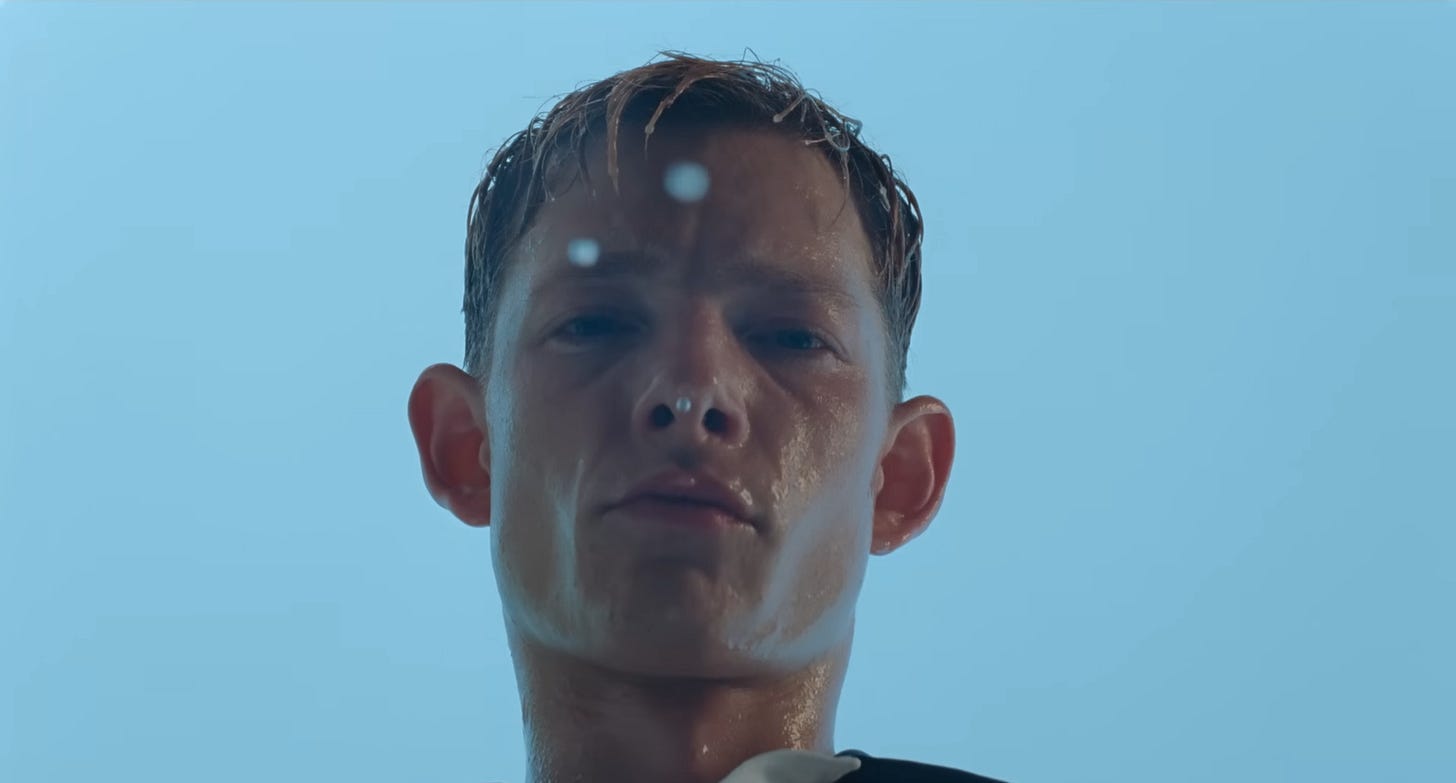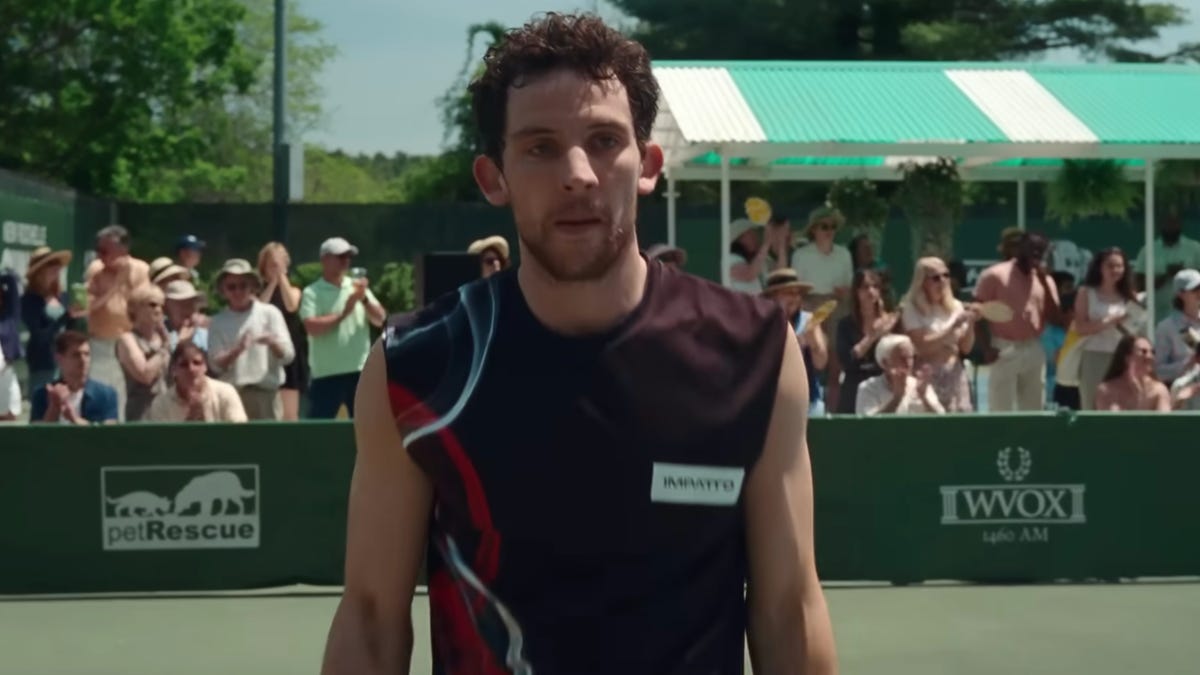it's more than just tennis: challengers (issue 20)
maybe the true challenger was the gayness we tried to repress but instead, manifested itself in sports
Challengers is undoubtedly Zendaya’s film. She is the biggest star of the cast, most promotional material revolves around her, and the film’s tagline even reads “Her game, her rules.” It is evident this film is being used to take her from acclaimed television actress to film actress, which is certainly plausible. However, Challengers is not a film that relies heavily on its female lead or character. Tashi is shown to be a fiercely independent and headstrong woman whereas the men, Art Donaldson and Patrick Zweig, need each other and Tashi more than she needs them. Rather, Tashi moves an outside force entering this relationship and an object for the men to focus on rather than their undercurrents of queerness. Challengers asks these men: who do you need more, the woman you pine after or your other man? Is pursuing her the thrill or is it the parallel sexual conquest you’re experiencing with your friend/rival/childhood best friend?
From the beginning, it is clear there is an undercurrent of queerness between Patrick and Art. They explicitly tell Tashi about the time Patrick taught Art how to masturbate, they are in constant proximity, and the only foods they eat throughout the film are phallic (bananas, hot dogs, the churros that Patrick feeds to Art). It is brimming with sexuality, yet the closest they get is during their doubles win celebration where they scream and hug each other which ends in an unnoticed sexual position on the court and when Tashi gets them to kiss in front of her. The homoeroticism is clear and the film spends the entire time focusing on these two to illustrate the gayness found within male sports.
It is no surprise Luca Guadagnino, the director and a gay man himself, makes queerness an explicit theme throughout the film. Several of his other films deal directly and indirectly with queerness, especially his last three films (Call Me By Your Name, Suspiria, Bones and All). It took me until Challengers to revisit these films mentally and realize Guadagnino’s main concern as a director is conveying passion through physicality. Susie’s dancing and summoning of her mother, the tenderness of Maren and Lee’s love, and the pining and yearning from both Oliver and Elio are all shown to be all-consuming connections conveyed through touch or feeling. By using bodies in his films this way, Guadagnino reveals their humanity, equating the human body to the human spirit. With these tennis players, touch is limited but the emotions are ravaging. Despite the lack of sex scenes, the film practically bubbles over with built-up sexuality and fervor. Yet, Challengers uses the physicality of the body and the relationship of tennis to convey these emotions of desire.
Rather, Challengers use physical bodies instead of physical touch. Almost every shot during the tennis matches, regardless of the film’s timeline as if to suggest this desire between these three is omnipresent, is a mesmerizing dissection of the body. Biceps, forearms, calves, thighs, glutes, and hands all make one shot each, completely analyzing each part of the body from all three players. They are sexualized but rarely objectified. They are shown to be highly physical beings, yet their relationships are never consummate through sex; tennis matches are where they are consumed. Every game, match, and set drips with sweat that is edited to sound like rain pattering, a justifying connection considering how powerful the emotions each person feels. Seeing these people fight for their stakes in this love triangle is delightfully salacious and exciting because sex is never a consideration for their pent-up emotions and passions. They’re always talking about tennis.
This love triangle is also beautifully contained, away from outside forces. Even guards of gender expectations are shredded to pieces at the clamoring hands of everyone involved. Tashi spearheads her needs for love and success herself. Defiant and headstrong, her charisma and mind for understanding people through facades within mere seconds is established early, making her the most captivating party in the trio as she manages to pull the strings of both boys. Zendaya’s steeliness and coldness make her all the more intriguing, where the audience never fully gets to see her guard down which speaks to her innate excellence as a tennis player.
Josh O’Connor plays Patrick’s levels of empathy with magnetic finesse. During his low moments, he seems wounded and helpless, yet the fire in his eyes makes it clear he has something planned. His ability to know Tashi and Art deeply also makes him incredibly entrancing as he dances around the other two. Mike Faist, on the other hand, plays Art straightforwardly; there is always a sense of earnestness in every moment. It makes him dependable for Tashi, yet malleable for Patrick’s trick.
Early on in the film at Tashi’s party, she discusses how tennis is a mutual understanding, a relationship. Thus, as the timeline flashes back to understand what transpired between the trio, the match between Art and Patrick heats up. As the audience leans more into the inner lives of these players, the camera does too. The first minutes of the match utilize wide shots and impersonal angles. By the climax, the audience is in it, quite literally focusing on every muscle shake, bouncing back and forth, watching Tashi’s surging anxiety as her bob shakes back and forth to watch two men fight for her, for glory, and against each other and their emotions.
During these verbal spats and tennis volleys, the incredible score by Trent Reznor and Atticus Ross fills the sound. Whether it’s the film’s signature pulsating, electrifying club music, the softer piano during Tashi’s second encounter with the boys, or the choir that accompanies emotional scenes, the score easily takes center stage during these tense scenes.
All these incredible aspects of filmmaking accumulate into such a tense, highly emotive film with heights I have not felt in such a long time. Coming into it, I had high hopes and Guadagnino’s last three films are all in my top ten favorite films of all time. I was excited to see how he films tennis volleys and how he captures this love triangle where every corner touches. I was blown away by everything in the film. However, to circle back to the beginning, even I was not expecting Challengers to take on such visible homoeroticism.
In my experience of an all-boys high school where sports took precedence over all else, it became normalized for me to see fellow students and players having similar interactions as Patrick and Art do in the Open tournament. Constant touching and unabashedly showing affection to people on the field; there was never any shame in leaning into it when sports were involved. Challengers’s brilliance lies in this nugget of truth: straight men are sometimes the gayest people and homoeroticism is intrinsic in sports. Patrick and Art obviously both have a crush on Tashi, but in more ways, they need each other more. They speak in the sauna lowly of each other, but neither recognizes they need this relationship. There is unspeakable queerness that seems to bond men in sports. Bodies clash with each other, sweat glistens in the sun, physical closeness between the players. The film also understands this brotherhood and sexual relationships are one and the same because they both take an intimate knowledge of a person’s brain and physicality to connect. It is never repressed sexuality within sports either, because it never needed to be when men could explore it safely on the court, a place deemed safe for men to show emotions and passion. For Art and Patrick, their tennis bonded them with passion, knowledge, and intimacy in a way that cannot be eradicated over time.
While Tashi is the central figure, she can easily be removed as she does during their three-way kiss. Neither men stop and the camera lingers on the passion between them. Similarly, Tashi, taking both of them under, may have separated them physically, but never emotionally; in fact, it can be argued she made arrangements for them both to end up in the finale together. For Patrick and Art, the challenger game is bursting with sexuality. Grunts, body parts, and sweat all fly across the screens. The film cuts in a frenzy as they push and pull. It is their way of connecting because their entire relationship is built around tennis and their sportsman bond, hence why they played doubles. While she knows much of the extent of their relationship, Tashi sits outside this; for her, she just wanted to see some good fucking tennis.
To close this little review and appreciation piece of what could potentially be my favorite film of the year, I am doing the most important piece of film journalism: ranking Challengers' product placement from best to worst.
Dunkin Donuts
When Patrick was eating the hell out of that bagel sandwich, I felt that. Saw this on a Monday and immediately made me excited for my Friday Dunkin run.
Applebees
I’d recognize that molten lava chocolate cake anywhere. Loved the Something Wild and Desperately Seeking Susan posters.
Taco Bell
Boring and unnecessary.
Pepsi
Re: boring and unnecessary. The old logo made it look so refreshing though.
Sports name I don’t know
I really couldn't care less.







